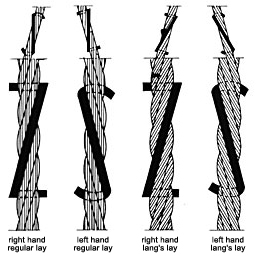|
| 1. | Construction
of Wire Rope The design of a rope is determined by: STRAND CONSTRUCTION The number and arrangement of wires in each strand ROPE CONSTRUCTION The number and arrangement of strands in each rope |
 |
||||||||||
| 2. | Grades
of rope wire Young Heung wire ropes are made of steel wires classified into following tensile strength grades to meet various requirements according to the applications.
|
|||||||||||
| 3. |
Wire rope lay
|
 |
 |
 |
 |
 |
||||
Galvanized
Steel Wire Rope Ungalvanized Steel Wire Rope Stainless SteelWire Rope |
PVC
Coated Steel Wire Rope |
Point
Contact Lay Rope |
Marine Rope | ||||
|
|
 |
 |
 |
 |
||||||||
Elevator
Rope |
Non-Rotating Rope |
Linear
Contact Lay Rope 6x19 Class |
Linear
Contact Lay Rope 6x37 Class |
||||||||
|
|
|
|
| << Back to MARINE |